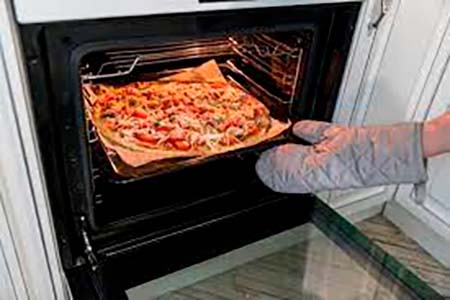This guide delves into the intriguing pizza box conundrum, exploring whether it’s safe and advisable to use one in your oven. Before you embark on this culinary experiment, it’s essential to understand the potential risks and benefits, making an informed decision to enjoy your reheated pizza without any unexpected mishaps. Let’s unravel the mystery of whether you can put a pizza box in the oven, all while prioritizing safety and practicality.
The Pizza Box Conundrum

Understanding the Components
Before delving into whether you can put a pizza box in the oven, it’s crucial to understand the components of a typical pizza box. Pizza boxes are typically made of corrugated cardboard, designed to insulate and protect your pizza during transport. They feature several key elements:
- The Base: This is the flat, bottom part of the box that holds your pizza. It’s usually covered in a layer of wax or grease-resistant coating to prevent the pizza’s oils from seeping through.
- The Lid: The top part of the box, often connected by a hinge, serves to close and secure the box. It usually features a design or logo related to the pizzeria.
- Side Flaps: These are the smaller flaps on the sides of the box that can be folded down to keep the lid in place. They play a role in keeping your pizza warm during transport.
- Vents: Some pizza boxes have small ventilation holes on the lid to allow steam to escape, preventing the pizza from becoming soggy.
Now that we understand the basic components of a pizza box, we can explore whether they can safely go into the oven for pizza reheating purposes.
Common Concerns and Myths
As the idea of reheating pizza with the pizza box in the oven gains popularity, several common concerns and myths have emerged. Let’s address these issues to better understand the practicality and safety of this method.
- Fire Hazard: One of the most significant concerns is the possibility of the pizza box catching fire in the oven. While it’s true that cardboard is flammable, the risk of a fire occurring during reheating is relatively low. The oven temperature typically used for reheating pizza (around 350°F to 450°F or 175°C to 230°C) is not hot enough to ignite cardboard, which ignites at much higher temperatures.
- Toxic Fumes: Some worry that heating a pizza box may release toxic fumes from the ink, adhesives, or coatings on the cardboard. In reality, modern pizza boxes are designed with food safety in mind. They use food-grade inks and adhesives, and the wax or grease-resistant coatings are food-safe. Heating the box within the safe temperature range does not pose a significant risk of toxic fume release.
- Soggy Pizza: Reheating pizza in the pizza box may cause concerns about the pizza becoming soggy due to trapped steam. While it’s true that pizza boxes are designed to trap heat and moisture, it doesn’t necessarily result in a soggy crust. The steam can help maintain the pizza’s moisture, preventing it from drying out. However, if you prefer a crispy crust, it’s advisable to use a different reheating method.
- Cardboard Taste: Some worry that heating the pizza box could transfer a cardboard taste to the pizza. This concern is valid to some extent. While cardboard itself is relatively flavorless, heating it can release subtle odors or flavors. However, this is generally not strong enough to significantly impact the taste of the pizza.
- Energy Efficiency: Reheating pizza in the pizza box can be seen as less energy-efficient compared to using a baking sheet or a pizza stone. Since the pizza box is not a good conductor of heat, it may take slightly longer to reheat the pizza, potentially using more energy in the process.
- Environmental Impact: Using a pizza box for reheating raises questions about environmental impact. Cardboard is recyclable, but if it’s heavily soiled with food residues, it may not be accepted by recycling facilities. Opting for reusable methods like a baking sheet or a pizza stone can be a more environmentally friendly choice.
Can You Put a Pizza Box in the Oven?

Before deciding whether to put a pizza box in the oven, several crucial factors should be considered to ensure safety and satisfactory results.
- Pizza Box Type: Not all pizza boxes are created equal. Ensure that the pizza box is clean and free of any visible food residues or grease stains. It’s also important to confirm that the box is made from plain, uncoated cardboard without any plastic or wax coatings. These coatings can release harmful fumes when heated.
- Pizza Toppings: Consider the type of pizza you’re reheating. Simple toppings like cheese or vegetarian options are more likely to reheat well in the box. Pizzas with a lot of moisture-rich ingredients like extra sauce, vegetables, or juicy meats may increase the risk of sogginess.
- Oven Temperature: Preheat your oven to a moderate temperature between 350°F to 450°F (175°C to 230°C). This range is safe for cardboard and allows for efficient reheating. Avoid using the oven’s broiler setting, which generates extremely high heat.
- Pizza Placement: Place the pizza box with the leftover pizza in the center of the oven rack. Ensure that there is space around it for proper air circulation. Placing it directly on the oven rack allows heat to circulate evenly, preventing potential scorching.
- Heating Time: Keep a close eye on the pizza while reheating. The time required can vary based on your oven’s efficiency and the thickness of the pizza. Start with a reheating time of 5-10 minutes and check for doneness. If needed, continue reheating in short increments to avoid overcooking.
- Monitoring for Doneness: Look for visual cues to determine if the pizza is done. The cheese should be fully melted, and the crust should become crispy or reach your preferred level of doneness. If using a food thermometer, ensure the internal temperature reaches a safe 165°F (74°C).
- Use Oven Mitts: When removing the pizza box from the oven, use oven mitts or potholders to protect your hands from the heat. Remember that the box will be hot.
- Safe Handling: Allow the pizza to cool briefly before opening the box and serving. Steam trapped in the box can be very hot, so exercise caution to prevent burns.
- Alternative Methods: While reheating pizza in the pizza box is an option, consider alternative methods such as using a baking sheet, pizza stone, or cast iron skillet. These methods often provide crisper results and reduce concerns about cardboard taste or sogginess.
- Environmental Considerations: If you’re environmentally conscious, think about the impact of reheating in a pizza box. Cardboard can be recycled if it’s clean, but heavily soiled boxes may not be accepted by recycling facilities. Reusable methods may align better with your sustainability goals.
Exploring the Risks
While reheating pizza in a pizza box is a common practice, it’s not without its risks and concerns. Understanding these potential issues is essential to ensure a safe and enjoyable pizza-eating experience.
- Fire Hazard: One of the primary risks associated with reheating a pizza box in the oven is the potential for a fire hazard. Pizza boxes are made of cardboard, which is a flammable material. If the oven temperature is too high or if the box gets too close to a heating element, it can catch fire. This risk is particularly high when using the broiler setting, which generates intense heat.
- Cardboard Taste: Cardboard can impart an undesirable taste to the pizza when exposed to high temperatures. This can result in a less enjoyable dining experience as the pizza may absorb a cardboard-like flavor. This is more likely to occur when reheating for an extended period or at very high temperatures.
- Sogginess: Depending on the type of pizza and its toppings, reheating in the box can sometimes lead to a soggy crust. Pizzas with a lot of moisture-rich ingredients, such as extra sauce, vegetables, or juicy meats, are more susceptible to becoming soggy when reheated in a closed box.
- Ineffective Heating: Reheating in a closed box may not always provide even or efficient heating. The box can act as an insulator, trapping moisture and preventing the pizza from crisping up properly. This can result in unevenly reheated slices.
- Food Safety Concerns: Reheating pizza, especially with toppings like meat or dairy, carries food safety considerations. It’s essential to ensure that the internal temperature of the pizza reaches a safe level to kill any potential bacteria. Using a food thermometer to confirm that the pizza reaches at least 165°F (74°C) is advisable.
- Environmental Impact: While cardboard is recyclable, reheating pizza in the box may limit its recyclability. Heavily soiled boxes, especially if they contain leftover food or grease, may not be accepted by recycling facilities. This can have environmental implications, and it’s worth considering alternative reheating methods that reduce waste.
- Potential for Uneven Heating: Reheating in a pizza box can sometimes lead to uneven heating, with the center slices being less heated than those near the edges. This can result in an inconsistent dining experience.
- Overcooking: If not monitored carefully, the pizza can overcook or burn when reheated in a closed box. Overcooking can lead to a dry and unappetizing pizza.
Removing Contaminants
if you’ve decided to proceed with reheating pizza in the box, it’s crucial to take steps to remove contaminants and reduce potential risks. Here are some guidelines to ensure safer reheating:
- Inspection: Before placing the pizza box in the oven, carefully inspect it for any visible contaminants or leftover food debris. Remove any loose particles or stains from the box’s interior to reduce the risk of burning or generating unpleasant odors during reheating.
- Food Safety: Ensure that the pizza was properly stored before reheating. If it has been sitting out at room temperature for an extended period, it may have reached an unsafe temperature, promoting bacterial growth. If in doubt, it’s safer to discard the pizza.
- Oven Preparation: Preheat your oven to a moderate temperature, typically around 350°F (175°C). Using a lower heat setting reduces the risk of cardboard ignition and minimizes the cardboard taste transfer to the pizza.
- Elevate the Pizza: To prevent direct contact between the pizza and the oven rack, use a clean oven-safe pan or baking sheet to elevate the pizza box slightly. This helps distribute heat more evenly and reduces the risk of cardboard scorching.
- Monitor Closely: Keep a close eye on the reheating process. Avoid using the broiler setting, which generates intense heat and poses a higher risk of cardboard ignition. Check the pizza frequently to ensure it’s not overcooking.
- Use a Food Thermometer: To ensure food safety, use a food thermometer to check the internal temperature of the pizza. The pizza should reach at least 165°F (74°C) to kill any potential bacteria. Insert the thermometer into the thickest part of a pizza slice to get an accurate reading.
- Ventilation: If your oven has a ventilation system, use it to help remove any odors that may result from reheating the box. Adequate ventilation can also reduce the risk of smoke or combustion.
Guidelines for Using a Pizza Box in the Oven

Reheating pizza in a pizza box in the oven is a unique approach that can yield satisfactory results if done correctly. To ensure safety and delicious results, follow these guidelines:
- Check the Pizza Box Material: Ensure that the pizza box you intend to use in the oven is made of plain cardboard, with no glossy or waxed coatings. Glossy or waxed boxes can release harmful chemicals and pose a fire hazard.
- Remove Any Non-Paper Elements: Before placing the pizza box in the oven, remove any non-paper elements such as stickers, plastic windows, or metallic clasps. These can release toxic fumes when heated.
- Inspect for Grease or Food Residue: Examine the inside of the pizza box for any leftover grease or food residue. If present, clean it as thoroughly as possible. Grease and food remnants can increase the risk of fire or generate unpleasant odors when reheated.
- Preheat the Oven: Preheat your oven to a moderate temperature, typically around 350°F (175°C). Using a lower heat setting reduces the risk of cardboard ignition and minimizes the cardboard taste transfer to the pizza.
- Elevate the Pizza Box: To prevent direct contact between the pizza and the oven rack, use a clean, oven-safe pan or baking sheet to elevate the pizza box slightly. This helps distribute heat more evenly and reduces the risk of cardboard scorching.
- Place Pizza in the Box: Put the slices of pizza back into the clean and prepared pizza box. Ensure that they fit comfortably without crowding, which can affect the even reheating of the pizza.
- Monitor Closely: Keep a close eye on the reheating process. Avoid using the broiler setting, which generates intense heat and poses a higher risk of cardboard ignition. Check the pizza frequently to ensure it’s not overcooking.
- Use a Food Thermometer: To ensure food safety, use a food thermometer to check the internal temperature of the pizza. The pizza should reach at least 165°F (74°C) to kill any potential bacteria. Insert the thermometer into the thickest part of a pizza slice to get an accurate reading.
- Ventilation: If your oven has a ventilation system, use it to help remove any odors that may result from reheating the box. Adequate ventilation can also reduce the risk of smoke or combustion.
- Safety First: Always prioritize safety. If you notice any signs of the pizza box beginning to scorch or smoke, immediately turn off the oven and carefully remove the box using oven mitts. Allow it to cool before assessing any damage or continuing reheating.
- Alternative Reheating Methods: If you’re uncomfortable with the idea of reheating pizza in the box or if you’re unsure about the box’s suitability, consider alternative reheating methods, such as using a pizza stone, skillet, or microwave. These methods can provide more precise control over the reheating process and minimize the risks associated with cardboard and potential contaminants.